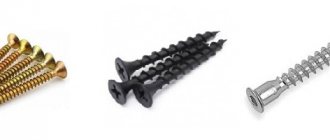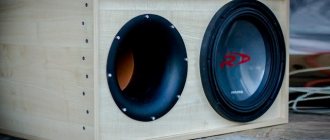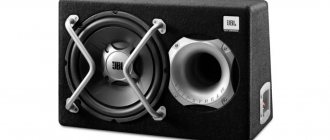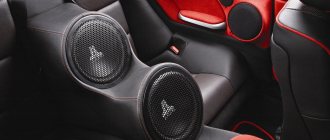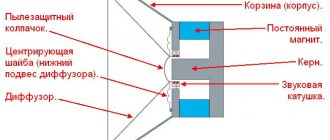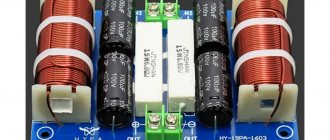- Tuning
- Car audio
Apr 25, 2014
Before you start designing and assembling the box, you need to decide on the choice of speaker. We recommend choosing 10-12 inch imported speakers, as they are most often used in car subwoofers and are best suited. We described in detail how to choose a speaker for a subwoofer in a previous article. The design of the box is also important: the quality and volume of low-frequency sound depends on it.
What types of subwoofer boxes are there?
There are several types of subwoofer boxes. you get at the output directly depends on the design of the box Below are the most popular types of subwoofers:
A closed box is the easiest to manufacture and design; its name speaks for itself. The woofer is housed in a sealed wooden housing, which improves its acoustic performance. Making a subwoofer in a car with such a housing is quite simple, but it has the lowest efficiency.
A 4th order bandpass is a type of subwoofer whose body is divided into chambers. The volumes of these chambers are different; in one of them there is a speaker, and in the second there is a bass reflex (air duct). One of the features of this type of subwoofer is the design's ability to limit the frequencies that the cone reproduces.
The 6th order bandpass differs from the 4th order by the presence of another bass reflex and another camera. There are two types of 6th order bandpasses - the first has one bass reflex, and the second has two (one of them is common to both cameras). This type of box is the most difficult to design, but produces maximum efficiency.
A bass reflex is a subwoofer with a special tube in the housing. It vents air and provides additional sound from the rear of the speaker. In terms of complexity in manufacturing and sound quality, this type is a cross between a closed box and a bandpass.
If you want to get the highest quality sound, you can opt for bandpasses. But this type of design has many details that must be carefully designed and calculated. All this can be done using a special program WinlSD, which will not only determine the optimal size and volume of the subwoofer, but also create a 3D model of it, and also calculate the dimensions of all parts.
Unfortunately, this program requires at least minimal knowledge in this area and the average car enthusiast is unlikely to be able to do everything right the first time. Moreover, in order for the program to work correctly, it needs some speaker parameters, which are also not known to everyone. If you do not plan to take part in car audio competitions, we advise you to discard the bandpasses.
Are you interested in auto tuning? Detailed instructions for installing parking sensors with your own hands especially for you!
Do you know what tiptronic is? Read the article about the pros and cons of this gearbox.
A bass reflex will be the most optimal solution for a homemade subwoofer. This type of box is good because the tube (bass reflex) allows you to better reproduce the lowest frequencies. In fact, this is an additional sound source that contributes to the sound of the subwoofer and increases efficiency.
Operating principle
Motorists may be familiar with a resonator, another example of which is the CV box For example, it is used as a functional element of a muffler. In this case, the hollow structure has its own characteristics and another purpose.
From a technical point of view, a resonator is an oscillatory system that accumulates vibrations due to frequency resonance. Typically, the design involves “working” with a limited set of frequency characteristics. Depending on the design, resonators of cumulative and instantaneous action differ.
Homemade wooden box
The storage resonator accumulates external energy by reducing the frequency of internal oscillations. In a mathematical context, any resonator design whose oscillation frequency is greater than the oscillation frequency of the external influence is cumulative. This happens whether the diameter is 10 or 12 inches, but you need to choose a different volume.
Instantaneous action implies the correspondence of the internal oscillatory force in period to external oscillations. Such resonators increase the sound power due to thermal absorption of the surrounding space, shifting the frequency at the input power - changes due to an increase in the playback interval.
The common CV box has a rectangular shape with partitions resembling a caterpillar in arrangement. The appearance will depend on the speaker and its features, size – 10″ or 12 inches. At the moment, you can find drawing diagrams for any frequency device and make a resonator at no extra cost. It will differ slightly from the brand name.
What materials do we need to assemble the subwoofer?
The material for making the subwoofer box must be durable, dense and well insulating sound. Multilayer plywood or chipboard is perfect for this . The main advantages of these materials are their affordable price and ease of processing. They are quite durable and provide good sound insulation. We will make a subwoofer from 30 mm thick multilayer plywood.
To make a subwoofer box we will need:
- Wood screws (approximately 50-55 mm, 100 pieces)
- Soundproofing material (Shumka)
- Drill and screwdriver (or screwdriver)
- Jigsaw
- Liquid Nails
- Sealant
- PVA glue
- Carpet, approximately 3 meters
- Klemnik
How to calculate a resonator for the Urals yourself?
First of all, we note that the main material for making this audio device is multi-layer moisture-resistant plywood. The speaker input is sized according to the selected model. The volume and design will depend on the technical tasks: interior features, required power and other features.
Designs depending on the direction of the port
The figure shows that the direction of the port and other parameters also influence the design. Sometimes drivers, after making calculations, are concerned that the dimensions are very large compared to the available space in the cabin, so they recommend a design that is suitable for this task.
Other housing options
The photo shows an example of the calculation of the HF box, but in total the cross-sectional area of the tunnel is taken into account (for example, 10″ or 12″), depending on the caliber of the subwoofer, for example, Machete m10d2.
Example
Use the Quarter Wave Box calculation program. You will only need to enter the speaker parameters and box volume. Otherwise you will have to make the drawings yourself.
To do this, use ready-made recommendations - a table with subwoofer sizes for 10, 12 inches and others. The cells show the volume that needs to be taken as a basis to achieve certain audio parameters. A “tuning” is also selected depending on the machine owner’s preferences and frequency. The box can be designed for two or more speakers, they can be different 10″ or 15″.
The proposed variations demonstrate some solutions for organizing a car interior media system that are available for self-production. With a little effort, you will get a high-quality sound system in your car for your new Machete m10d2 or Ural, taking into account the features of your interior and preferences.
Before you start planning and building the box, you need to decide on the selection of the subwoofer itself. We recommend that you choose ten to twelve inch subwoofers, because they are most often used in the construction of boxes and are best suited to them. The structure of the box is also of significant importance: the quality and volume of low-frequency sound directly depends on it. At the moment there are several options for speaker boxes. The main thing is to make the right choice, because the sound quality will depend on it.
Types of subwoofer boxes
How to calculate the volume of a box for a speaker
- An 8" (20 cm) speaker requires 20-33 liters of net volume
- For a 10-inch (25 cm) subwoofer you will need 34-46 liters
- For a 12-inch (30 cm) subwoofer – 47-78 liters
- For 15-inch (38 cm) speaker – 79-120 liters
- And for an 18-inch speaker (46 cm) you will need 120-170 liters.
Subwoofer box drawings
In this article we will make a box for a subwoofer with a 12-inch speaker. The recommended box volume for one 10-12 inch speaker is 40-50 liters . Calculating a box for a subwoofer is not difficult, here is an approximate diagram with the dimensions of the panels.
It is worth paying attention to the minimum distance from the walls of the case to the speaker. It, like the volume of the entire box, is calculated based on the inner surface.
Video instruction: how to make a drawing for a subwoofer yourself
What's the result?
As you can see, the decision to make a housing for a subwoofer in a car with your own hands will require certain skills and tools. However, if you do everything correctly and use good quality materials, you can get a fairly powerful sub with good sound.
Finally, we note that after connecting the subwoofer, you also need to configure it. Only after proper adjustment and tuning of the subwoofer will the sound “reveal” to its fullest, which will allow you to fully customize the car’s acoustic system in the future.
Installing a subwoofer in a car: how to choose a subwoofer, installation diagram for a subwoofer in a car. Connecting a subwoofer through an amplifier or without an amplifier, recommendations.
How to set up a subwoofer in a car. Amplifier settings: frequency, phase, Gain, subsonic, etc. What to look for when setting up a subwoofer, recommendations.
How to connect a radio in a car yourself: sizes of radios, adapter frames. Features of connecting the radio if the connector does not fit. Recommendations.
Selecting PTF for VAZ 2114 and 2115: how to choose VAZ fog lights (housing, type of lamp, standard or universal, etc.). Installation of fog lights VAZ 2114, 2115.
How to connect PTF in a car yourself: do-it-yourself fog light connection diagram. Subtleties and nuances, what to pay attention to when connecting.
How to install a child car seat or infant carrier in a car: choosing a child seat, mounting features, installation location of the seat. Tips and tricks.
An HF box or quarter-wave resonator is a hollow box made of any furniture material. The design is used for a subwoofer and allows for deeper sound with a harmonious spectrum. Such branded devices are quite expensive, but the box can be assembled independently from scrap materials. This is exactly what we will discuss in our review.
Assembling a subwoofer box with your own hands
You can start assembling. We use a 12-inch Lanzar VW-124 speaker.
Its diameter is 30 cm, and the first thing you need to do is cut a hole for the speaker. The minimum distance from the center of the diffuser to the subwoofer wall is 20 cm. We measured 23 cm (20 cm + 3 cm plywood width) from the edge of the panel and cut a hole with a jigsaw. Next, we cut a hole for the bass reflex slot; in our example, it has a size of 35*5 cm.
Instead of a slot, you can use a classic air duct - a tube. Now we assemble the bass reflex slot and attach it to the front panel of the subwoofer. We go along the joints with liquid nails and tighten them with self-tapping screws.
It is important to tighten the screws very tightly so as not to leave any voids. They will create resonant vibrations that will ruin the sound of the subwoofer.
Next, we assemble the side walls of the box, having previously lubricated them with liquid nails, and tighten them tightly with self-tapping screws.
On the back cover of the box you need to cut a small hole for the terminal block. We connect all parts of the body. We make sure that we cut and fastened all the parts correctly.
We insert the speaker. Let's look and admire.
Let's move on to the interior decoration of the box. The first thing you need to do is seal all the joints and cracks with epoxy glue or sealant. Next, using PVA glue, we glue soundproofing material onto the entire inner surface of the box.
Now we cover the entire outer plane of the box with carpet, including the bass reflex slot. You can attach it with epoxy glue or using a furniture stapler.
Next, insert and screw the speaker tightly. The subwoofer is almost ready, all that remains is to stretch the wires from the speaker to the terminal block and connect the amplifier.
We bought an additional amplifier, but you can also make it yourself. This is quite difficult, as it requires knowledge and practice in the field of radio engineering. You can also use ready-made kits and circuits for radio amateurs, like Master-KIT, and assemble the amplifier yourself. The only requirement for the amplifier is that its maximum power must be less than the maximum power of the speaker .
See also a video report on making a homemade subwoofer for 2 speakers
Case manufacturing process
Measure the space for the elements and mark the cut locations with a pencil; assembly accuracy is very important; if you make a mistake by a few millimeters, everything will be askew.
The parts are inserted into each other and glued, then rough processing (machine), polishing. The edges should be rounded (sandpaper sequentially 120-> 200-> 400). Places that are difficult to reach with a spray gun should be pre-painted with a brush or roller.
Varnishing is done with low air pressure (2 atmospheres) and a large nozzle, maintain appropriate doses of paint, too large drops cause stains (try it on a simple board first). If someone wants to mill, work with great caution, but it is better to leave this task to someone who has a CNC machine.
The protective grille for the speaker will be made of perforated metal sheet.


